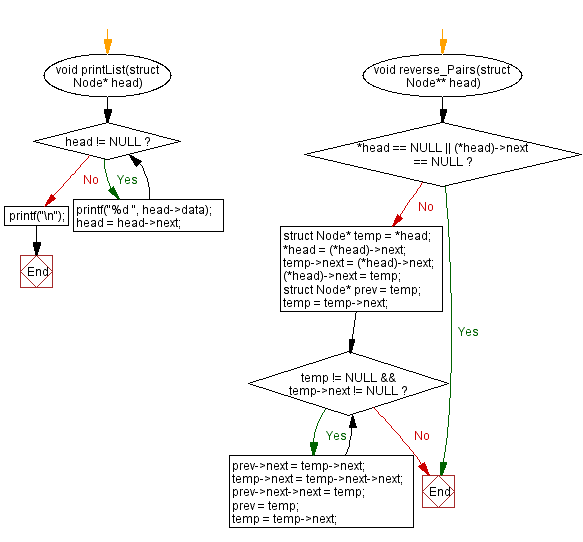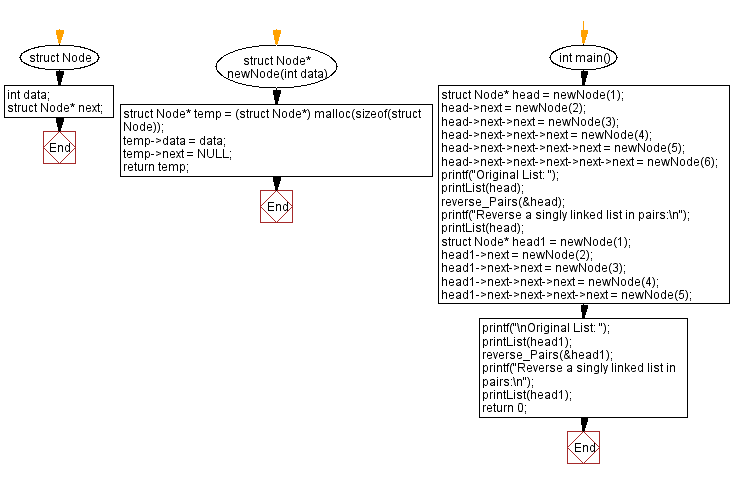C Exercises: Reverse a singly linked list in pairs
31. Pairwise Reversal Challenges
Write a C program to reverse a singly linked list in pairs.
Sample Solution:
C Code:
#include<stdio.h>
#include <stdlib.h>
// Structure defining a node in a singly linked list
struct Node {
int data; // Data stored in the node
struct Node* next; // Pointer to the next node
};
// Function to create a new node in the singly linked list
struct Node* newNode(int data) {
struct Node* temp = (struct Node*) malloc(sizeof(struct Node)); // Allocate memory for a new node
temp->data = data; // Assign data to the new node
temp->next = NULL; // Initialize the next pointer as NULL
return temp; // Return the new node
}
// Function to print the elements of the linked list
void printList(struct Node* head) {
while (head != NULL) {
printf("%d ", head->data); // Print the data of the current node
head = head->next; // Move to the next node
}
printf("\n");
}
// Function to reverse the singly linked list in pairs
void reverse_Pairs(struct Node** head) {
if (*head == NULL || (*head)->next == NULL) return; // If the list is empty or has only one element, return
struct Node* temp = *head;
*head = (*head)->next; // Update the head to point to the second node
temp->next = (*head)->next; // Adjust the first node's next pointer to point to the third node
(*head)->next = temp; // Adjust the second node's next pointer to point to the first node
struct Node* prev = temp; // Set the previous node as the first node
temp = temp->next; // Move to the third node
// Reverse pairs of nodes until the end of the list or a single node is left
while (temp != NULL && temp->next != NULL) {
prev->next = temp->next; // Point the previous node to the next pair's starting node
temp->next = temp->next->next; // Skip the next pair's starting node
prev->next->next = temp; // Reverse the next pair and connect it to the previous pair
prev = temp; // Move to the next pair's starting node
temp = temp->next; // Move to the next pair
}
}
// Main function
int main() {
// Creating and populating the first linked list
struct Node* head = newNode(1);
head->next = newNode(2);
head->next->next = newNode(3);
head->next->next->next = newNode(4);
head->next->next->next->next = newNode(5);
head->next->next->next->next->next = newNode(6);
printf("Original List: ");
printList(head); // Displaying the original list
reverse_Pairs(&head); // Reverse the linked list in pairs
printf("Reverse a singly linked list in pairs:\n");
printList(head); // Display the list after reversing pairs
// Creating and populating the second linked list
struct Node* head1 = newNode(1);
head1->next = newNode(2);
head1->next->next = newNode(3);
head1->next->next->next = newNode(4);
head1->next->next->next->next = newNode(5);
printf("\nOriginal List: ");
printList(head1); // Displaying the original list
reverse_Pairs(&head1); // Reverse the linked list in pairs
printf("Reverse a singly linked list in pairs:\n");
printList(head1); // Display the list after reversing pairs
return 0;
}
Sample Output:
Original List: 1 2 3 4 5 6 Reverse a singly linked list in pairs: 2 1 4 3 6 5 Original List: 1 2 3 4 5 Reverse a singly linked list in pairs: 2 1 4 3 5
Flowchart :


For more Practice: Solve these Related Problems:
- Write a C program to reverse nodes in groups of three in a singly linked list.
- Write a C program to reverse nodes in pairs recursively without using additional memory.
- Write a C program to reverse nodes in pairs only when the sum of the pair is an even number.
- Write a C program to reverse nodes in pairs and then swap the positions of the reversed pairs within the list.
Go to:
PREV : Reordering by Parity Challenges.
NEXT : Halving the List Challenges.
C Programming Code Editor:
Have another way to solve this solution? Contribute your code (and comments) through Disqus.
What is the difficulty level of this exercise?
